The easiest F-roads in Iceland are those that either don’t contain any river crossings or their terrain is simply easy to drive. Many F-roads often lead to stunningly beautiful landscapes of the Icelandic Highlands. These are one of the most beautiful highland roads in the world and you should definitely visit at least some of them when you are in Iceland during summer!
Contents
- 1. (F)35, Across Iceland
- 2. (F)208 North, Fjallabak
- 3. (F)570, Snæfellsnes
- 4. F347, Kerlingarfjöll
- 5. F575, Snæfellsnes
- 6. F225, Landmannalaugar
- 7. F235, Langisjór
- 8. F586, Haukadalsskarðsvegur
- 9. F821, Eyjafjarðarleið
- 10. F936, Eastfjords
- List of F-roads with NO river crossings
- Weather, Safety, and Driving Advice
It’s not easy to find information about what are the F-roads without river crossings and which roads are not steep, narrow, or dangerous in any other way. That’s why we collected all this info for you based on our multi-year driving experience in Iceland.
Below you will find the list of F-roads we consider the easiest to drive and suitable even for those with little 4×4 driving experience. The list is ordered based on the difficulty and starts with the easiest road, based on road conditions and obstacles.
When planning your Icelandic trip, please choose a proper car in advance, based on where you plan to drive. It’s also useful to know how to pick the best Icelandic car rental insurance. Moreover, we collaborate with the best Icelandic companies to offer you car rental and tour discounts and us a small commission at no extra cost to you.
1. (F)35, Across Iceland

F35, Kjölur, Kjalvegur
Why is it worth a drive
Firstly, if you want to easily traverse from southern Iceland to the north, Road (F)35, Kjalvegur, or Kjölur (yes, these are all names for the same road) will be your best choice.
Secondly, the two of the most beautiful Highlands areas of Iceland are located right in the middle of (F)35:
- The orange mountains of Kerlingarfjöll – one of the best hiking areas in the highlands
- Hveravellir hot springs – interesting hot spring area with one free hot pool for visitors
Personal Tip: Both Kerlingarfjöll and Hveradalir have become quite popular. If you want to enjoy them alone, arrive either early in the morning or late in the afternoon.
Why is it easy
F35 is the easiest F-road in Iceland and it’s not exactly an F-road anymore. It has been reclassified in recent years to a non-F-road 35. The reason why is, there are no unbridged rivers to cross, and, on top, significant road improvements were made to Kjalvegur.
Road 35 is just bumpy with many potholes, but otherwise, it’s completely OK to drive with no difficult parts or steep sections.
When to drive it
Despite being easy to drive, F35 is passable for visitors with rental cars only in summer. Kjalvegur typically opens the first among all F-roads, around the end of May.
It then usually becomes impassable due to snow in early October. Between October and May, only super jeeps are allowed on the road and only at their own risk.
Recommended car
A 4×4 car is NOT compulsory on Kjalvegur. Once the Icelandic Road Administration marks the road open, or passable, you can drive it in any car. It will be a more comfortable drive in a 4wd car with higher ground clearance, though.
2. (F)208 North, Fjallabak
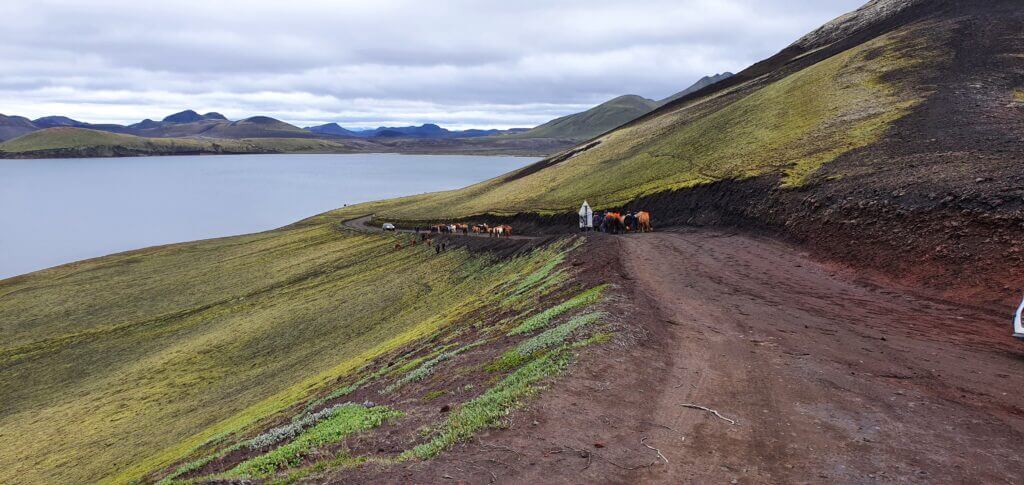
Horses blocking the F208 road Fjallabaksleið Nyrðri north of Landmannalaugar
Why is it worth a drive
Firstly, F208 North, or Fjallabaksleið Nyrðri in Icelandic, is the easiest road leading to picturesque Landmannalaugar.
Secondly, several otherwordly natural landscapes are situated along northern Fjallabaksleið Nyrðri, such as:
- Sigöldugljúfur canyon – famous and touristy canyon with waterfalls and crystal blue color
- Hnausapollur (Bláhylur) crater lake – probably the most photographed crater lake in Iceland
- Ljótipollur crater lake – one of the most beautifully-colored volcanic lakes in Iceland
- Frostastaðavatn lake – a huge lake right next to Landmannalaugar
- Tungnaárfellsfoss waterfall – a glamorously wide waterfall almost nobody visits and nobody knows about
- Dynkur (Búðarhálsfoss waterfall) – a very remote canyon with a big waterfall. Exercise caution, it’s further away from Road 208 and low-quality dirt tracks lead there.
Personal Tip: Road 208 North is pretty boring as such. Once you gain more experience with Icelandic highland roads, we recommend taking different routes back from Landmannalaugar.
Why is it easy
F208 North is also one of the very easy F-roads. The are no river crossings on northern (F)208. Moreover, the route has been reclassified to non-F-road in recent years due to road improvements. It’s not steep, nor narrow, just bumpy.
When to drive it
F208 North typically opens to visitors with rental cars around mid-June and typically closes near the end of September. This means you can drive with a rental car on F208 only in summer.
Recommended car
A 2wd car is sufficient for the northern part of (F)208 when it’s marked open. Nevertheless, we recommend driving it in a 4wd car with some ground clearance for a more comfortable drive. Such a car is also useful for many connecting roads, such as F225 or southern F208.
3. (F)570, Snæfellsnes
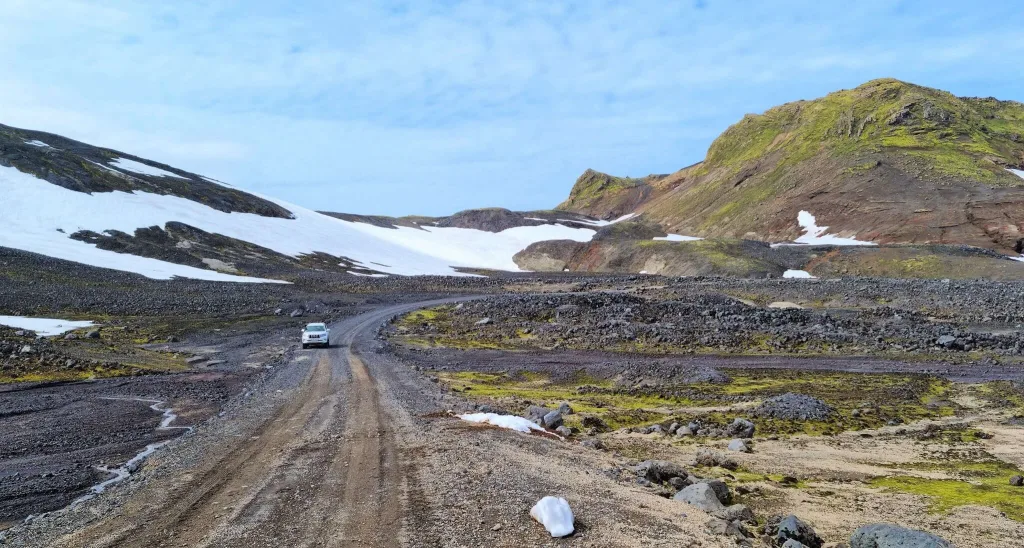
Road 570 Snæfellsness near Snæfellsjökull
Why is it worth a drive
Firstly, there are no special spots or attractions along Road 570, Jökulshálsvegur. But – that does NOT mean the road is not interesting. It’s actually in our opinion one of the most beautiful roads in Iceland. The colorful surroundings of F570 are on their own worth the drive!
Secondly, there’s a plateau roughly in the middle of F570, with stunning views of the southern Snæfellsnes beaches. Definitely go for it on a nice day with clear skies, and enjoy the views!
Personal Tip: Road (F)570 leads to the bottom of the trailhead for Snæfellsjökull - the highest point of the Snæfellsnes peninsula. The hike goes over a glacier with unstable terrain and crevasses, never attempt it alone!
Why is it easy
There are no river crossings on F570, that’s why the road has also been reclassified to non-F-road recently and it’s quite easy to drive. The road is a bit steep, though, so if you are afraid of heights, we do not recommend driving it.
When to drive it
Road 570, Jökulshálsvegur, standardly opens around the beginning of July and closes near the end of September. Always watch out for current road conditions, though. For example, during our drive of (F)570 in July of 2022, the road became passable as late as on 19th of July, due to deep snow still covering the road – see video above.
Even after opening in mid-July, it was passable only for 4×4 cars (despite being non-F-road). Long story short – the bigger 4×4 car is always an advantage and always check road conditions before driving any mountain roads in Iceland!
Recommended car
After a mild winter, you can drive Road 570 in a 2wd car. However, when there’s more snow, Jökulshálsvegur is passable only in a 4wd car. Bear this in mind.
4. F347, Kerlingarfjöll
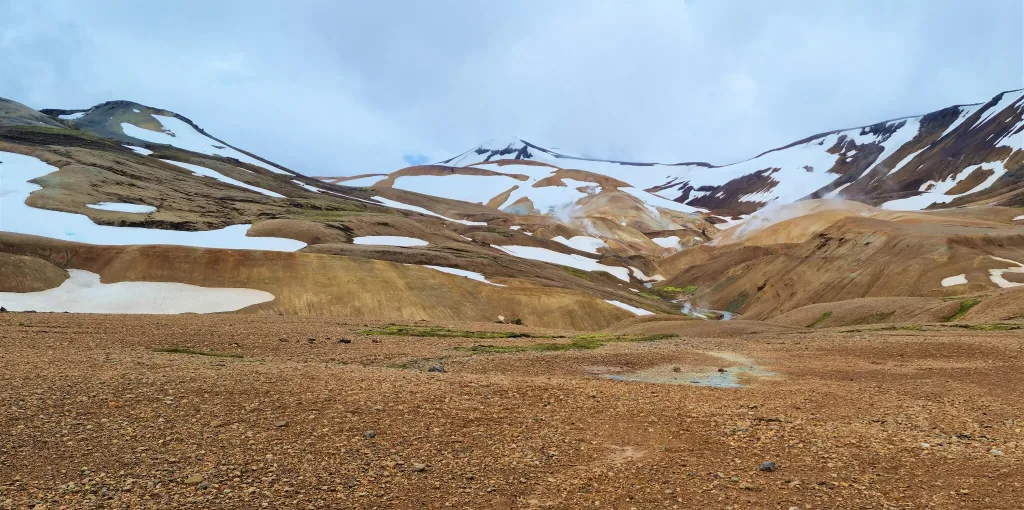
F347 Kerlingafjallavegur leading to Kerlingarfjöll, Hveradalir
Why is it worth a drive
First of all, F347, Kerlingafjallavegur, leads to one of the most spectacular areas of the Icelandic Highlands – the orange mountains of Kerlingarfjöll. That on its own is more than just worth a drive.
Secondly, my insider tip would be – don’t visit just Hveradalir hot springs area in Kerlingarfjöll! Almost everybody heads only to Hveradalir. And that’s a pity. There are many other amazing spots in Kerlingarfjöll and along F347:
- Snækollur hike – the highest peak of Kerlingarfjöll with by far the best views
- Kerlingarfjöll hot spring – a natural hot spring located in a picturesque canyon
- Horseshoe Bend – one of the favorite spots for photographers
- Hveradalir hot springs – the main and most popular hot spring area in Kerlingarfjöll
- Gýgjarfoss waterfall – a cute little waterfall right along F347
- Kerlingarfjöll mountain resort – a brand-new luxury mountain resort
- Hveravellir hot springs – another great hot spring area; one-hour drive from F347
Personal Tip: Kerlingarfjöll is located in a special glacier microclimate. This unfortunately means, it's almost always foggy, cloudy and/or rainy. If you are flexible, be patient and try to find a day with clear skies to visit it. Trust me, it will be worth it!
Why is it easy
F347 is the easiest F-road in Iceland that is still officially being marked as an F-road. There are no river crossings on Kerlingafjallavegur nor on the connecting road (F)35. The road will most likely be reclassified to non-F-road soon, more so thanks to the new Kerlingarfjöll mountain resort.
The only difficult part of road F347 is the last section between the mountain resort and the Hveradalir hot springs area, which is a bit steep.
When to drive it
F347 typically opens once all the snow from the road melts. Given the proximity of the glacier, this usually happens around the beginning of July. However, due to a new mountain resort, it’s reasonable to expect the road will be much better maintained in the future and will open even sooner, around May or June.
As of now, F347 typically becomes impassable around mid-to-end September. We again expect this to be prolonged due to the resort, to sometime around October or November. F347 may in the future even be the only road in the highlands accessible also in winter. Watch out for the latest road developments on Icelandic Road Administration website.
Recommended car
F347 can easily be driven in any 4wd car. It is still compulsory to drive a 4×4 car on the road because it’s still marked as an F-road. This may change in the upcoming months/years, though.
5. F575, Snæfellsnes
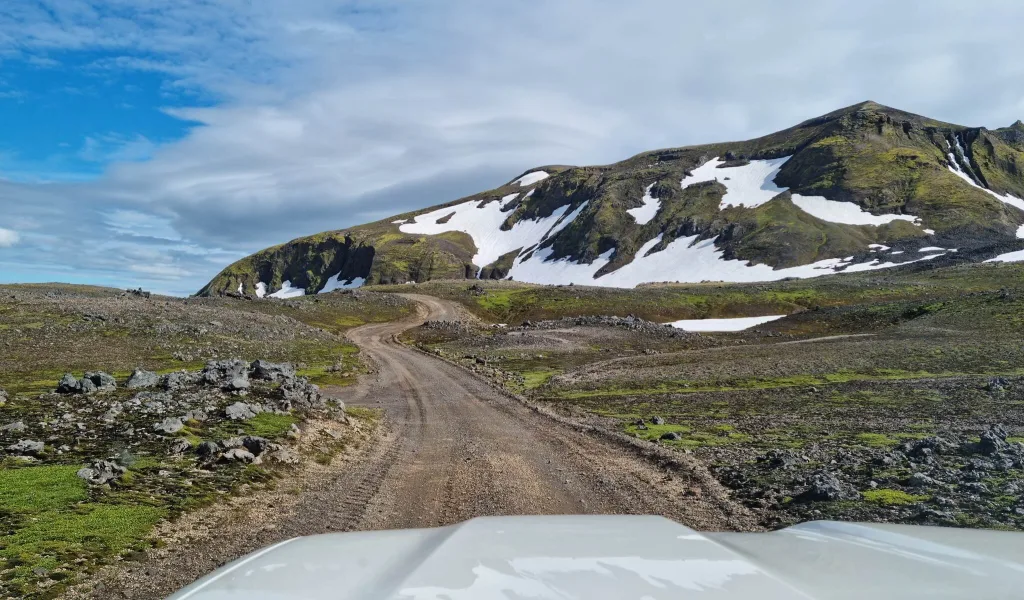
F575 Eysteinsdalsleið, Snæfellsnes in mid-July
Why is it worth a drive
To begin with, the drive around F575 is full of lush green hills, valleys, and snowfields making it a beautiful colorful mountain drive a very few visitors take. F575, Eysteinsdalsleið, is a mountainous F-road in Snæfellsnes that leads up to Snæfellsjökull glacier. It connects the western Snæfellsnes coast with road (F)570.
Furthermore, there are several lesser-known places to see in Snæfellsnes around the road F575, for example:
- Rauðhóll crater hike – very little visited crater, close to the road
- Eyvindarhola Lava Cave – an old cave with old bones
- Klukkufoss waterfall – hidden waterfall; requires hiking
- Snekkjufoss waterfall – another hidden waterfall that you need to hike to
- Scenic views from above – views from F575 on a clear day are simple breath-taking
Personal Tip: The drive on F575 takes only around 30 minutes. However, if you want to fully explore the entire area around, you will need around 5-6 hours for it. Plan accordingly.
Why is it easy
F575 doesn’t have any river crossings or any dangerous parts. It’s just a mountainous road where you will be driving up the hill for the entire time when coming from the west coast.
Eysteinsdalsleið may easily be reclassified in upcoming years to a non-F-road. I believe the only reason why it has not happened yet are some steep sections, remoteness of the road, and snow staying on the road often longer.
When to drive it
F575 becomes usually passable around the beginning of July and becomes again impassable around the end of September. This varies depending on the strength of the preceding winter and the quickness of the arrival of an upcoming winter.
In years of a soft winter, the road may open as soon as mid-June, and in years with harder winters (for example 2022) it opens as late as mid-July.
Recommended car
You can drive F575 in any 4wd car. A 4×4 car is compulsory on the road because it’s an F-road. Bear in mind the road has some steep sections and you will definitely feel safer driving a bigger 4wd car, though.
6. F225, Landmannalaugar
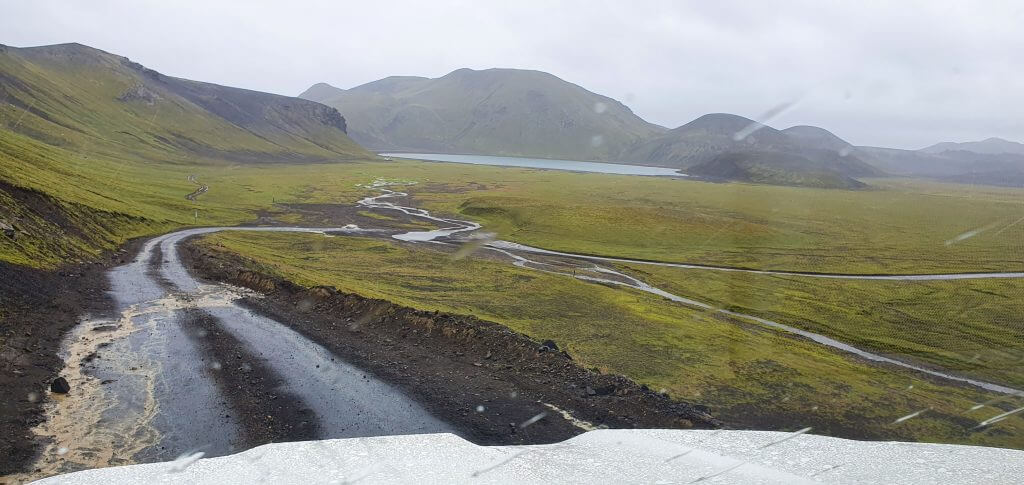
F225 Landmannaleið in rain
Why is it worth a drive
F225, Landmannaleið, is the second easiest road leading to Landmannalaugar. We believe that in July and later on, this is the best road to Landmannalaugar for first-time visitors. Why? F225 has amazingly beautiful surroundings and it’s easy to drive. It’s much, much more beautiful than the very often used northern road (F)208. Although there’s one river crossing, it’s an easy one, which we believe everyone can make when following river crossing rules.
Beware of the early season, though! The river crossing on F225 can get pretty watery and dangerous to pass in June, or generally early in the season when glaciers thaw. During this time, at least a Hilux / Land Cruiser is recommended.
Furthermore, there are many amazing hidden places around F225:
- Rauðaskál crater – incredible volcanic crater where you either need to hike from below, or drive with a super jeep from above
- Hekla volcano – famous volcano where you may hike in summer when weather conditions are good; the road leading to the hike is very difficult, though, and requires a super jeep
- Raudufossar waterfall – one of the most incredible orange waterfalls in Iceland; you need to hike there
- Raudufossafjol waterfall hike – the extension of the Raudufossar waterfall hike to the source of its orange water
- Landmannahellir hiking area – a campsite in the middle of a hiking area
- Domadalur ravine – scenic road in between volcanic hills full of black ash
- Frostastaðavatn lake – one of the biggest lakes in Landmannalaugar with beautiful surroundings
Personal Tip: If you are unsure about the river crossings in Iceland and you want to practice somewhere first, F225 is a very good road for it between mid-July and September. There are only small and easy river crossings on the road.
Why is it easy
There are no dangerous or steep sections on F225 and only small river crossings and ponds. It’s a good F-roads for practicing for any first-time visitors with some 4wd driving experience. There’s also usually good network coverage and a lot of traffic in the summer.
Just again – take special care in the early season! This is the time of the most water in the river crossing.
When to drive it
F225 typically opens among the first F-roads, around mid-June. This can move for about 2 weeks sooner or later based on the preceding winter intensity. Landmannaleið then typically becomes impassable around the end of September or the beginning of October.
Recommended car
A 4wd car is necessary for F225. Basically, any 4×4 car would be sufficient because this is an easy F-road anytime later in the season (mid-July to September). Not early in the season, though! The river crossing can get quite watery at that time, and at least a Hilux / Land Cruiser is recommended if this happens.
Bear in mind, though, that if you want to drive via some of the difficult detours from F225 like the Krakatindur dirt track, up above Rauðaskál crater, or towards Hekla, you will need at least a large 4×4 car, ideally a super jeep.
7. F235, Langisjór
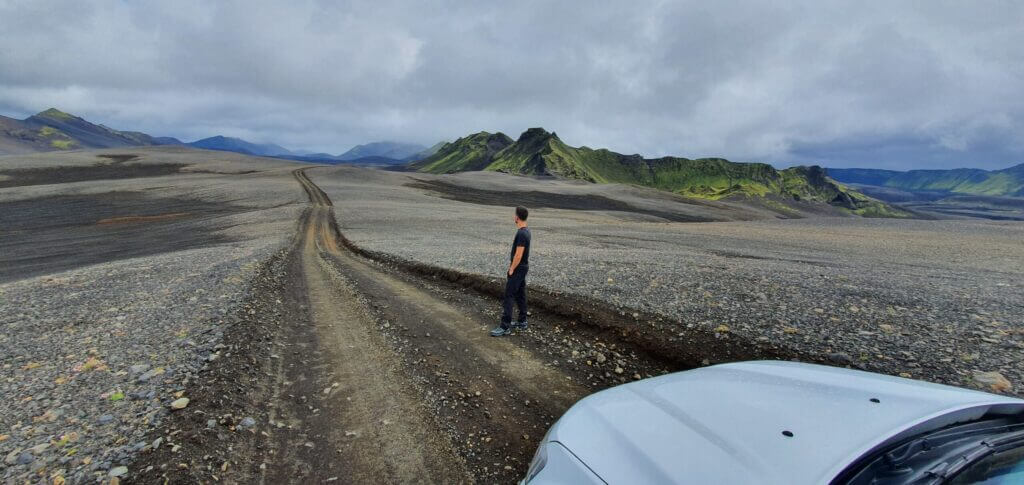
Out-of-this-world landscapes surrounding the F235 road toward Langisjór Lake
Why is it worth a drive
Despite being located deep in the Icelandic Highlands, road F235 surprisingly belongs to one of the easiest F-roads in Iceland. At the same time is one of the most astonishing roads in Iceland at all. Out-of-this-world lunar landscapes surround F235 to Langisjór from the start until the end. And once you finish, a beautiful reward will be waiting for you – an unbelievably clear Langisjór lake.
Although the surreal landscapes encompassing F235 would be strong enough a reason to drive the road, there’s more to see around:
- Sveinstindur hike – one of the most spectacular hidden Icelandic hikes
- Blue River Valley viewpoint – viewpoint of a beautiful crystal blue river valley
- Difficult dirt tracks – there are many fascinating connecting tracks for experienced drivers with large cars and super jeeps
- Lake Langisjór – huge and amazingly clear and tranquil lake; you can hike around it for days
- Eldgjá hiking area – a nice hiking area in the valley next to F235
Personal Tip: F235 should not be your first 4x4 experience. The road is easy to drive, but it's very remote and you need to cross one medium-sized river on F208 to reach F235.
Why is it easy
There are only small river crossings and ponds on F235 leading to Langisjór. Other than these there are no difficult parts and the road is easy to drive, almost like a highlands highway.
There’s one catch, though. To get to F235 you need to arrive by F208 either from the north or from the south. Both of these routes contain medium-sized river crossings. The northern route has several ones and the southern route has just one medium river crossing. When you rent at least a medium-sized SUV and follow the river crossing rules this should not be a problem, though.
When to drive it
F235 usually becomes passable and snow-free at the beginning of July. Some years this may happen a few weeks earlier and in some years a few weeks later. By mid-July the road should almost always be open to visitors. F235 then usually becomes impassable around the end of September.
Recommended car
To drive F235 we recommend at least a medium-sized 4×4 car. As we mention above, F235 as such is quite easy and would require only a small 4wd car. However, connecting southern F208 is harder and you definitely need a medium 4wd car such as Dacia Duster at minimum to pass safely under most of the weather and river conditions.
8. F586, Haukadalsskarðsvegur

Road F586 Haukadalsskarðsvegur
Why is it worth a drive
F586 is an easy F-road with a little bit of everything and well suitable as an F-road driving practice for beginners. Haukadalsskarðsvegur will serve you shallow river crossings, exhilarating inclines, and just enough potholes and rugged patches to keep your heart racing. But don’t worry – this road never gets too wild or intimidating.
What sets the F586 apart, though, is the refreshingly green landscapes that surround you as you journey onwards. To add to the magic, there’s a little canyon nestled right beside the road on its eastern side, just waiting to be explored.
Personal Tip: If you're ready to take on the Icelandic F-roads but want to start with a gentle yet unforgettable adventure, the F586 is your go-to destination.
Why is it easy
There are only small river crossings on F586 and all the inclines and declines are moderate and bearable. The road is also located near the main roads and is short in distance.
When to drive it
F586 typically becomes passable for visitors in the second half of May and usually closes in the first half of October.
Recommended car
You can drive F586 in any 4wd car, which is, however, compulsory for the road. For peace of mind, we suggest driving Haukadalsskarðsvegur in a medium-sized SUV.
9. F821, Eyjafjarðarleið
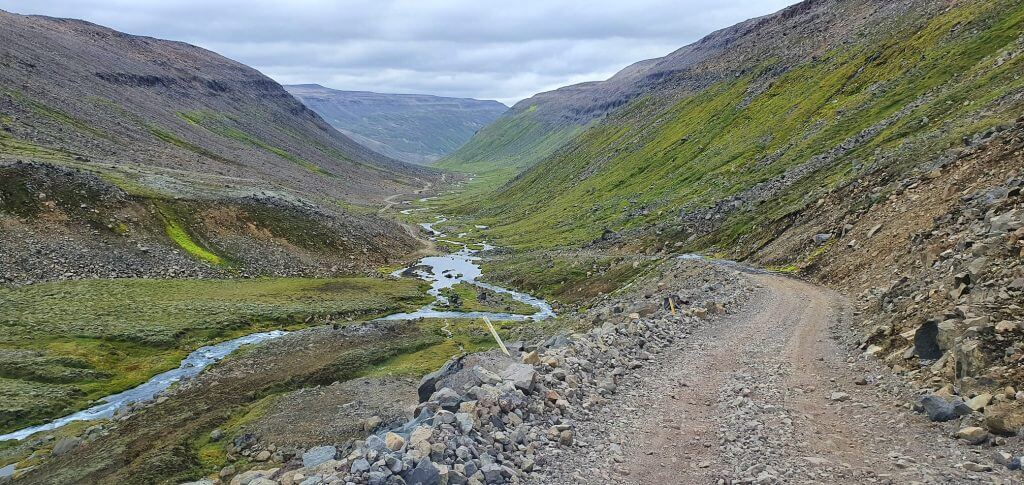
F821 Eyjafjardarleid
Why is it worth a drive
F821 is a scenic mountainous drive through a valley full of small river streams and moss around every corner. Besides the gorgeous drive, F821 also leads to Laugafell – one of the most secluded hot springs and campsites in Iceland. Laugafell is a peaceful oasis of remoteness in the middle of nowhere, and if you haven’t visited it yet, you should!
Highlights of F821:
- Laugafell hot spring – well-maintained remote Highland hot spring with a campsite
- Eyjafjardara Valley – one of the best roadside viewpoints in northern Iceland
- Green summer scenery – horses, farms, rivers, hills
Personal Tip: You will get the best views over the Eyjafjardara Valley if you arrive from the south and descend towards Akureyri. This is also the easier way to drive Eyjafjarðarleið because you don't have to take steep ascents. You need to drive the northern part of F26 first and then continue via F881. These road sections should normally be doable with only small rivers to cross.
Why is it easy
There are only small rivers and streams on F821, so river crossings are not an issue. The only potentially problematic aspect of the road is its inclination and rough terrain. This is not a road for someone trying to learn how to drive a 4×4 car, but it’s definitely one of the easier F-roads.
When to drive it
F821 is one of the latest roads to open in summer. The median opening date happens to be around mid-July, and definitely don’t expect to drive the road sooner than in July. Eyjafjarðarleið then typically closes around the end of September.
Recommended car
A 4wd is compulsory on F821, the same as it is for any F-road. More experienced drivers should be able to drive the road in any 4wd car. That being said we better recommend taking at least a medium-sized 4×4 car for the road, to not risk damaging your car on rough and steep terrain.
10. F936, Eastfjords
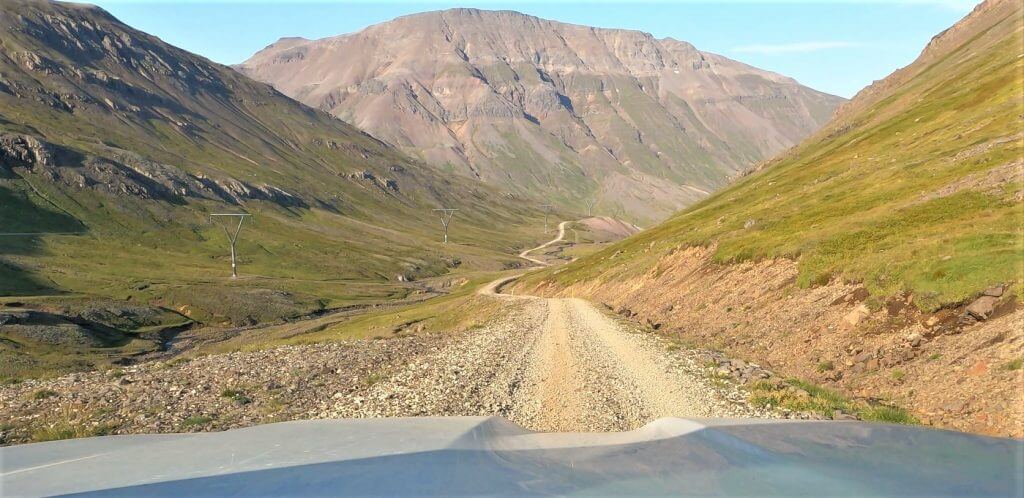
F936 (or 936 already) – Thordalsheidarvegur
Why is it worth a drive
F936 is kind of an outsider road because we have never noticed anybody talking or writing about it. I stumbled upon Þórdalsheiðarvegur just by looking at the map trying to find the roads I haven’t driven yet 🙂 Well, and it was worth a drive.
Although there are no special attractions along (F)936, the road itself is an attraction. Zig-zagged drive through huge Eastfjords valleys with no cars anywhere nearby made road 936 a little hidden road gem for us.
Personal Tip: Road 936 leads along the power lines. These go from Kárahnjúkar dam to Alcoa Fjardáal aluminum smelting company that consumes five times more power per day than the capital city Reykjavik. And this road is basically just a service road for them.
Why is it easy
F936 is not for the faint-hearted due to some pretty steep sections, however, these should be bearable for anyone with a 4×4 driving experience. There are also no rivers to cross on the road.
It is actually unclear whether the road is still an F-road (that’s why we wrote (F)936 at some points). On Icelandic Maps it’s just 936, but in front of the road there’s still a sign with “F936”.
When to drive it
(F)936 typically opens near the end of June and typically becomes impassable at the beginning of October.
Recommended car
While any 4wd should officially be feasible for the road (according to Icelandic Maps even a 2wd car), the bigger the car the better – at least for the steepest sections. Definitely take a 4wd car. We drove F936 in a Land Cruiser and it felt just right at the most difficult spots.
List of F-roads with NO river crossings
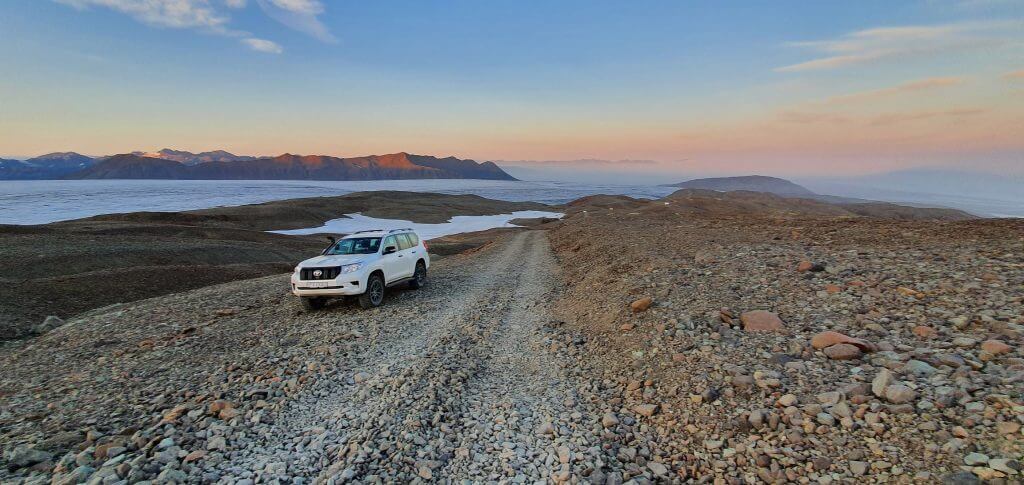
Amazingly beautiful sunset at the peak of F985, Jökulvegur, next to the Skalafellsjökull glacier
Here is a list of F-roads without any river crossings:
- (F)35, Kjalvegur
- (F)208 north, Fjallabaksleið Nyrðri
- (F)570, Jökulshálsvegur
- F347, Kerlingafjallavegur
- F575, Eysteinsdalsleið
- (F)936, Þórdalsheiðarvegur
- F985, Jökulvegur – very steep and narrow road leading to glacier
- F959, Viðfjarðarvegur – very steep and narrow road leading to the fjord
- F881, Dragaleið – easy road to drive, but a bit boring, and connecting roads have rivers to cross
- (F)508, Skorradalsvegur – nothing special about the road
- F333, Haukadalsvegur – a bit boring to feature
- F337, Hlöðuvallavegur – same as above
- F223, Eldgjárvegur – nice road to Eldgjá, but all connecting roads have river crossings, similar to F235
- F894, Öskjuvatnsvegur – a crazy, bumpy road to Askja; all connecting roads contain medium-sized river crossings
- F946, Loðmundarfjarðarvegur – steep mountainous road, not exactly an easy one
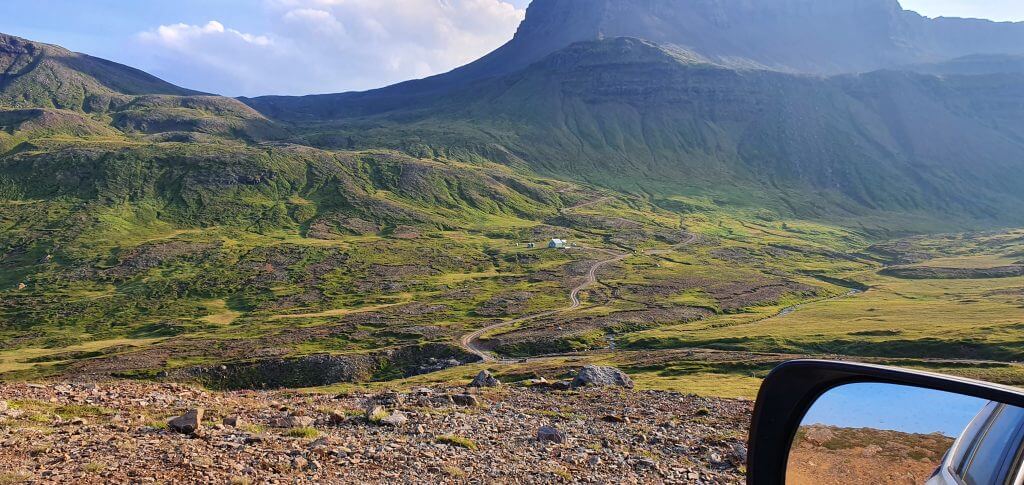
F946 Loðmundarfjarðarvegur Borgarfjörður Eystri
And here is the list of F-roads with only small river crossings:
- F225, Landmannaleið
- F235, Langisjór
- F586, Haukadalsskarðsvegur
- F821, Eyjafjarðarleið
- F66, Kollafjarðarheiði – a steep mountain pass connecting northern and southern Westfjords
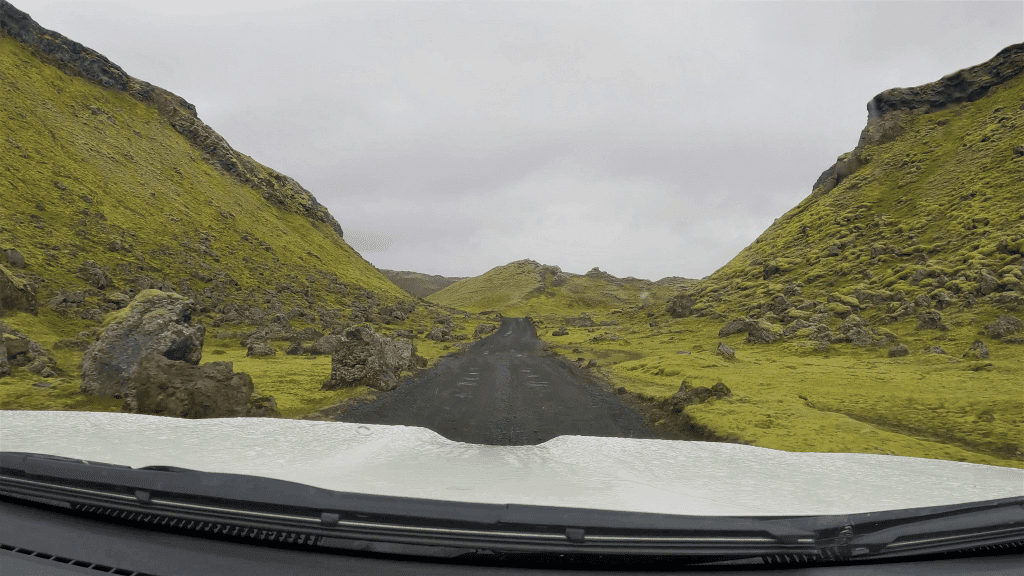
F223 Eldgjárvegur
Weather, Safety, and Driving Advice
- Always check first if the road you are planning to drive is marked passable, or green on the official Icelandic Road company website. Drive only if it is.
- Check for potential travel warnings on the Icelandic Safe Travel website before driving.
- Don’t drive difficult roads in bad weather, always check the official Icelandic weather forecast website. This is the only reliable source of weather information in Iceland.
- If you plan to cross rivers, always follow the river crossing guidelines to stay safe and not damage your car.
- If feeling unsure, better turn back, wait for help or go together with someone else.


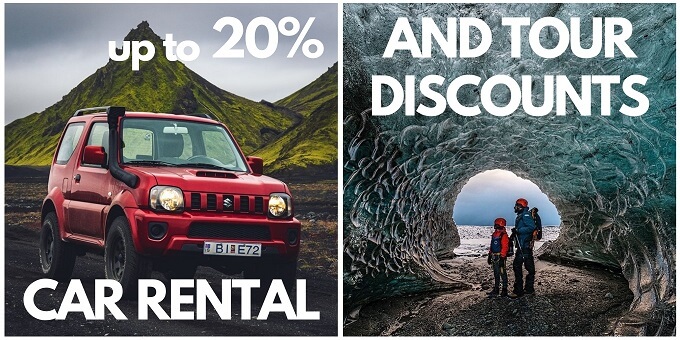
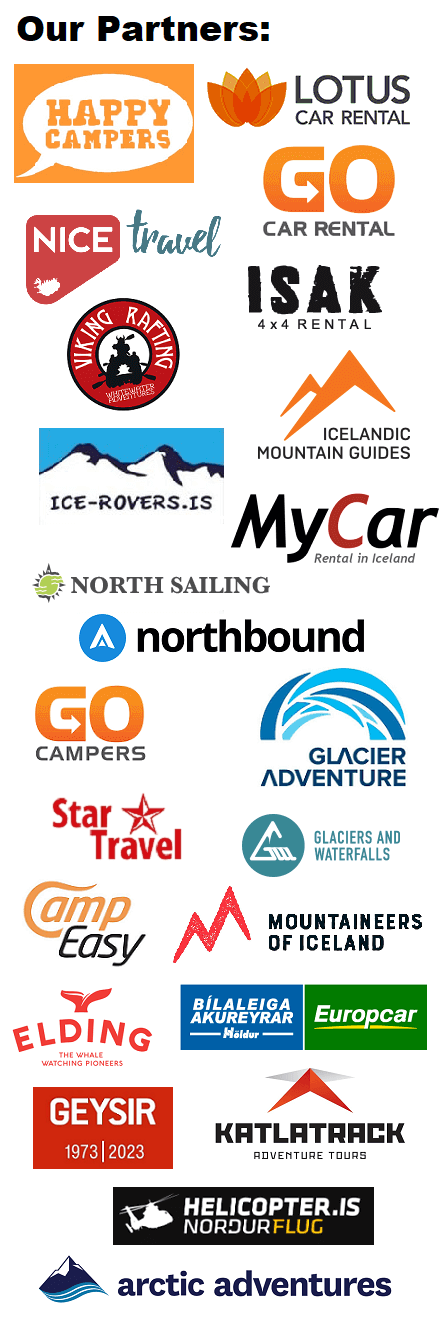

Hi,
I’m planning on being in Iceland on July 9 for 9 days. I’ve rented a 4×4 camper van (do I need heater ?) and hiking from skogafoss to Porsmork and catching a bus back to car the next day. I really want to stay around Landmannalaugar hike the loop trail.
Do you have suggestions as what routes to take to get from skogfoss to landmannalaugar? Thank you
Hi Deborah,
1) The heater in July really depends on your temperature comfort levels. I wouldn’t need it in a good sleeping bag. My wife on the other hand may need it. If you have a good sleeping bag, you should manage it I think even without.
2) There are 3 routes which you can take to Landmannalaugar, they vary with difficulty and also with beauty of the surroundings. We described them in detail in our Landmannalaugar guide.
Hi Igor,
we are planning to visit Iceland in late June 2025. We have approx. 14 days and would like to explore mainly via F-Roads, as we’ve been in Iceland with a 2WD before. Can you recommend a combination of manageable F-Roads that kind of covers a lot of Iceland?
Thank you very much!
Hi Daniel, we have a lot of articles on F-roads and their difficulties, as well as beauties along the roads. It highly depends on what car will you be driving, see for example:
So it’s impossible to give you a clear answer. Some of my personal must-dos that can be driven for example by a Land Cruiser include F208 south and F225 to Landmannalaugar, F206/207 to Laki, F235 to Langisjor, F905/910 to Askja, F233 to Maelifell and possibly many more 🙂
If you go for a super jeep rental, (which we highly recommend), then you can also most of the time safely take other amazing roads like F249 to Basar in Thorsmork, F210 and F261 around Fjallabak or F899 in the north near the shore or F985 up to the glacier.
Hallo Ipor, welche F-Strassen könnte man gut mit einem Dacia Duster Allrad fahren? Danke schön!
Hi Gabriele, under standard weather conditions you can drive all of the road mentioned in this article with Dacia Duster.
Just check http://www.trafficinfo.is before driving, if a road is green, you can go 🙂
Hi Igor,
Will be renting a Toyota RAV4 at the beginning of July, planning to do F206 to laki and F35. Rent company said this car is good for those. A bit worried though after reading about that middle size river on F206. Assuming no massive rain earlier, should it be safe to do that? Will a manual dacia duster be better somehow?
Thank you
Oz
Hi Oz,
Duster is slightly better but no big difference. If there’s not too much water in the rivers and if you cross the rivers correctly, you should be OK. But it’s always a lottery with these smaller city SUVs, to be sure to pass under various conditions it’s best to have a Land Cruiser or bigger in Iceland.
Hi Igor
I wonder if you could clarify the ability of the Suzuki Jimny please. We hired one last year and happily drove to Landmanalaugar (both routes) and down the F35. But it’s never mentioned as a go to 4×4 despite us seeing many others. Is this due to ground clearance or exhaust height or am I just wrong and it will go most places? We loved driving it although we got blown around a bit.
Thanks
Alan
Hi Alan, the capabilities of a Jimny are somewhat similar to e.g. Dacia Duster, so small to medium size SUV.
Being smaller, though, it’s a bit less stable compared to e.g. Duster.
Jimny is fine for easy to medium F-roads under good weather conditions. Not for anything more serious, though. Of course I’m talking about normal, unmodified Jimnys.
Hi Igor,
we tried the F225 today and the main crossing was really swollen. A fully modified 35 inch Jeep dipped into the water up to the hood when we were checking the crossing. We decided to turn around. As you said, you always have to assess the danger yourself and not blindly follow the posts here, but maybe its helpful for rivercrossing newbies to mention that the crossing can be pretty dangerous in early summer. Keep up the great work!